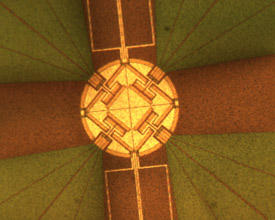

09/28/2015

© 2015 Jiri Orava
By probing crystallization rates in a special class of glasses known as chalcogenides, AIMR researchers have uncovered a ‘crossover’ in atomic mobility that may help optimize these glasses for next-generation computer memory cells1.
Chalcogenides such as germanium–antimony–tellurium (GST) and silver–indium–antimony–tellurium (AIST) switch between glassy and crystalline states on the application of an electrical pulse. This switching, which occurs on nanosecond time scales, makes chalcogenides attractive for writing and erasing digital bits since phase-change memory devices based on thin films can store data some 100,000 times faster than conventional magnetic hard drives.
One fundamental challenge with phase-change memory is the need to make switching rapid but not so easy that data storage becomes unstable. To get around this, designers exploit the strong effect of temperature on atomic mobility. For example, normally slow transformations to crystalline states can be hastened by heating to temperatures just below melting points.
The most common description of chemical reaction rates, known as the Arrhenius law, breaks down over the wide temperature range used by phase-change memory devices. Instead, researchers base their analyses on chalcogenide ‘fragility’, a measure of how viscous liquids deviate from Arrhenius kinetics at different temperatures.
Lindsay Greer and Jiri Orava from the AIMR at Tohoku University and collaborators in the United Kingdom applied ultrafast calorimetry — a technique that employs heating rates of over 10,000 kelvin per second — to measure heat flow during crystallization with sufficient precision to characterize kinetics over a wide, practical temperature span. The team had previously found that GST displays fragile liquid behavior. In contrast, their latest measurements of AIST chalcogenide crystal growth revealed that its temperature dependence appears to follow the Arrhenius law.
Careful calorimetry analysis of ‘supercooled’ liquid AIST samples (see image) suggested that this apparently simple temperature dependence results from a gradual crossover from the expected fragile behavior to a contrasting and more Arrhenius-like ‘strong’ behavior on cooling. This type of kinetic crossover parallels the behavior of water, explains Greer, but has never been explored for phase-changing chalcogenides.
“This study shows that the idea of selecting chalcogenides based on their fragility was too simple,” says Greer. “This shifts our attention from the degree of fragility to the crossover temperature itself, and there are already clues about how to tailor this parameter.”
“We cannot promise a revolution in device operation, but we expect this finding will lead to a much better understanding of performance limits,” he adds.
Orava, J., Hewak, D. W. & Greer, A. L. Fragile-to-strong crossover in supercooled liquid Ag-In-Sb-Te studied by ultrafast calorimetry. Advanced Functional Materials 25, 4851–4858 (2015). | article
This research highlight has been approved by the authors of the original article and all information and data contained within has been provided by said authors.